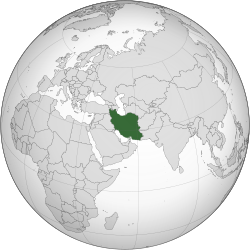
Back الدولة البهلوية Arabic الدوله البهلويه ARZ پهلوی حؤکومتی AZB রাজতন্ত্রী ইরান Bengali/Bangla ئێرانی پەھلەوی CKB Íránské císařství Czech Det Iranske Kejserrige Danish Iraani Keisririik Estonian ایران پهلوی Persian Iranin keisarikunta Finnish
Imperial State of Irana | |||||||||
|---|---|---|---|---|---|---|---|---|---|
| 1925–1979 | |||||||||
| Motto: مرا داد فرمود و خود داور است Marâ dâd farmud o xod dâvar ast "Justice He bids me do, as He will judge me"[2] | |||||||||
| Anthem: (1925–1933) سلامتی دولت علیهٔ ایران Salâmati-ye Dowla-te 'Aliyeye Irân "Salute of the Sublime State of Persia" (1933–1979) سرود شاهنشاهی ایران Sorud-e Šâhanšâhi-ye Irân[3] "Imperial Anthem of Iran" | |||||||||
 | |||||||||
| Capital and largest city | Tehran | ||||||||
| Official languages | Persian | ||||||||
| Religion | Shia Islam (majority and de jure official) Secular state (de facto)[a] | ||||||||
| Demonym(s) | Iranian Persian | ||||||||
| Government | Unitary parliamentary constitutional monarchy (de jure)[b] Unitary parliamentary semi-constitutional monarchy (de facto)[c]
| ||||||||
| Shah | |||||||||
• 1925–1941 | Reza Shah Pahlavi | ||||||||
• 1941–1979 | Mohammad Reza Pahlavi | ||||||||
| Regency Council (Iran) | |||||||||
• 1953 | Regency Council of Iran (1953) | ||||||||
• 1979 | Regency Council of Iran (1979) | ||||||||
| Prime Minister | |||||||||
• 1925–1926 (first) | Mohammad Ali Foroughi | ||||||||
• 1979 (last) | Shapour Bakhtiar | ||||||||
| Legislature | National Consultative Assembly (as a unicameral legislature; 1925–1949) Parliament (as a bicameral legislature; 1949–1979) | ||||||||
| Senate | |||||||||
| National Consultative Assembly | |||||||||
| Historical era | Interwar period • Second World War • Cold War | ||||||||
• Constituent Assembly votes in Pahlavi dynasty | 15 December 1925 | ||||||||
| 25 August – 17 September 1941 | |||||||||
• Admitted to the United Nations | 24 October 1945 | ||||||||
| 19 August 1953 | |||||||||
• Joined CENTO | 3 November 1955 | ||||||||
| 26 January 1963 | |||||||||
• Disestablished | 11 February 1979 | ||||||||
| 11 February 1979 | |||||||||
| Area | |||||||||
• Total | 1,648,195 km2 (636,372 sq mi) (17) | ||||||||
| GDP (PPP) | 1978 estimate | ||||||||
• Per capita | US$3,844 ($23,568.06 as of 2023)[A][3] | ||||||||
| Currency | Rial (ریال) (IRR)[3] | ||||||||
| ISO 3166 code | IR | ||||||||
| |||||||||
| |||||||||
The Imperial State of Iran, officially known in English as the Imperial State of Persia until 1935,[3] and commonly referred to as Pahlavi Iran,[d] was the Iranian state under the rule of the Pahlavi dynasty. The Pahlavi dynasty was created in 1925 and lasted until 1979, when it was ousted as part of the Islamic Revolution, which ended the Iranian monarchy and established the current Islamic Republic of Iran.
The Pahlavis came to power in 1925 with the ascension to the throne of Reza Shah, a former brigadier-general of the Persian Cossack Brigade, and the overthrow of Ahmad Shah Qajar, the last Iranian ruler under the Qajar dynasty. Iran's Majlis, convening as a constituent assembly on 12 December 1925, deposed the young Ahmad Shah Qajar and declared Reza Shah as the new shah of the Imperial State of Persia. In 1935, Reza Shah asked foreign delegates to use the endonym Iran instead of the exonym Persia when addressing the country in formal correspondence.
Reza Shah declared Iran neutral during the Second World War. Nonetheless, Iran was occupied by British and Soviet forces following the Anglo-Soviet invasion of Iran. Subsequently Reza Shah was forced to abdicate.
After Reza Shah's forced abdication, he was succeeded by his son, Mohammad Reza Pahlavi, who became the last Shah of Iran. By 1953, Mohammad Reza Shah's rule became more autocratic and firmly aligned with the Western Bloc during the Cold War in the aftermath of the 1953 Iranian coup d'état, which was engineered by the United Kingdom and the United States. In correspondence with this reorientation of Iran's foreign policy, the country became an ally of the United States in order to act as a bulwark against Soviet ideological expansionism, and this gave the Shah the political capital to enact a hitherto unprecedented socio-economic program that would transform all aspects of Iranian life through the White Revolution. Consequently, Iran experienced prodigious success in all indicators, including literacy, health, and standard of living. By 1978, the Shah faced growing public discontent that culminated into a full-fledged popular revolutionary movement led by religious cleric Ruhollah Khomeini. Mohammad Reza Shah went into exile with his family in January 1979, sparking a series of events that quickly led to the end of monarchy and the establishment of the Islamic Republic on 31 March 1979. Following Mohammed Reza Pahlavi's death in 1980, his son, Reza Pahlavi, now leads the exiled family throne.[5]
- ^ Whitney Smith (1980), Flags and Arms across the World, McGraw-Hill, ISBN 978-0-07-059094-6
- ^ "The Imperial Standards of Iran".
- ^ a b c d "IRAN: Keshvaré Shahanshahiyé Irân", The Statesman's Year-Book 1978–79, Springer, 2016, pp. 674–682, ISBN 9780230271074
- ^ "Iran between Islamic Nationalism and Secularism".
- ^ Parker Richards (29 January 2016). "Pahlavi, Elie Wiesel, Rev. King to Be Honored for Promoting Peace". Observer. Retrieved 1 June 2017.
Cite error: There are <ref group=lower-alpha> tags or {{efn}} templates on this page, but the references will not show without a {{reflist|group=lower-alpha}} template or {{notelist}} template (see the help page).
Cite error: There are <ref group=upper-alpha> tags or {{efn-ua}} templates on this page, but the references will not show without a {{reflist|group=upper-alpha}} template or {{notelist-ua}} template (see the help page).

